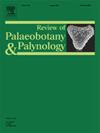阿根廷巴塔哥尼亚Deseado地块侏罗纪地热矿床中的柏木与护士原木生长策略的证据
IF 1.7
3区 地球科学
Q2 PALEONTOLOGY
引用次数: 0
摘要
柏科木材化石记录广泛分布于中生代和新生代,在两个半球分布广泛。然而,由于描述不完整、保存问题和解剖特征解释不明确,一些化石木材的亲缘关系尚不确定。本研究描述了保存完好的侏罗纪硅化木的解剖结构,并讨论了它们的亲缘关系。样品采集自阿根廷南巴塔哥尼亚圣克鲁斯省Deseado地块“Claudia”地区的地热矿床。其次生木质部为强氧木质部和均氧木质部,具有管胞上的混合麻点、以柏木形态排列的柏木交叉坑和丰富的弥漫性轴向薄壁组织等特征。这些特征与原柏树(Protocupressinoxylon)一致,表明其与柏科有亲缘关系。此外,保存这些木材碎片的燧石块含有与这个家族有亲缘关系的营养器官(如叶子、根),支持了所建议的联系。根据IAPT化石委员会关于该名称命名问题的建议,所研究的木材被分配到开放命名的protocupressinoxylon型木材,同时承认它在历史和当前的广泛使用。护士原木也被记录下来,这是基于一些被研究的树木上固定的一些茎和根的存在,这扩展了这种生长策略的化石记录。本文章由计算机程序翻译,如有差异,请以英文原文为准。
Cupressaceous woods in Jurassic geothermal deposits of the Deseado Massif, Patagonia, Argentina with evidence of nurse-log growth strategy
The fossil wood record of Cupressaceae is extensive across the Mesozoic and Cenozoic, with a wide distribution in both hemispheres. However, the affinities of some fossil woods are uncertain due to incomplete descriptions, preservation issues, and anatomical traits of ambiguous interpretation. This study describes the anatomy and discusses the affinities of well-preserved Jurassic silicified woods. Samples were collected from geothermal deposits at the ‘Claudia’ locality in the Deseado Massif, Santa Cruz Province, Southern Patagonia, Argentina. The material corresponds to pycnoxylic and homoxylic secondary xylem characterized by a distinctive combination of traits, including mixed pitting on tracheids, cupressoid cross-field pits arranged in a cupressoid pattern, and abundant diffuse axial parenchyma. These characteristics are compatible with Protocupressinoxylon and suggest affinities with Cupressaceae. Additionally, chert blocks preserving fragments of these woods contain vegetative organs (e.g., leaves, roots) with affinities with this family, supporting the suggested affiliation. The studied woods are assigned to the open nomenclature Protocupressinoxylon-type wood, following the IAPT Fossil Committee's recommendations concerning the nomenclature problems of this name, while acknowledging the extensive historical and current use of it. Nurse logs are also recorded based on the presence of several stems and rootlets anchored to some of the studied woods, which expands the fossil record of this growth strategy.
求助全文
通过发布文献求助,成功后即可免费获取论文全文。
去求助
来源期刊
CiteScore
3.50
自引率
21.10%
发文量
149
审稿时长
6 months
期刊介绍:
The Review of Palaeobotany and Palynology is an international journal for articles in all fields of palaeobotany and palynology dealing with all groups, ranging from marine palynomorphs to higher land plants. Original contributions and comprehensive review papers should appeal to an international audience. Typical topics include but are not restricted to systematics, evolution, palaeobiology, palaeoecology, biostratigraphy, biochronology, palaeoclimatology, paleogeography, taphonomy, palaeoenvironmental reconstructions, vegetation history, and practical applications of palaeobotany and palynology, e.g. in coal and petroleum geology and archaeology. The journal especially encourages the publication of articles in which palaeobotany and palynology are applied for solving fundamental geological and biological problems as well as innovative and interdisciplinary approaches.

 求助内容:
求助内容: 应助结果提醒方式:
应助结果提醒方式:


